Return to table of contents
History of Sugar Island
as the National Encampment of the ACA
(Commodore Larry Zuk has been going to Sugar Island for 80 of the first 100 years)
From its formation in 1880, the American Canoe Association held an annual National
Encampment at various locations. Interest in establishing a permanent location was further
directed toward the 1000 Island area when the National Camp was held at Grindstone Island
in 1884. The Executive Committee voted to start a search for a permanent site.
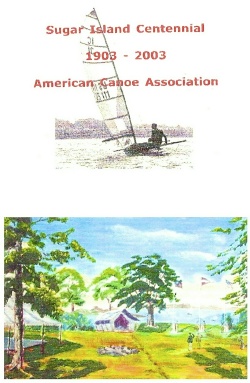 The Search Committee consisted of Robert Wilkin and Charles E. Britton of
Gananoque and resulted in the purchase of the Island. The deed states that the lands
described as part and parcel of those lands set aside for the use of the Mississaguas of
Alnwick Indians were sold to Charles Edward Britton, Commodore of the American Canoe
association, and Robert Wilkin, Chairman of the Board of Governors of the ACA, for the
sum of $1000.00. The sale was officially recorded in Ottowa as July 18,1901. Island 47 was
purchased in 1919 and some small islands later.
The Search Committee consisted of Robert Wilkin and Charles E. Britton of
Gananoque and resulted in the purchase of the Island. The deed states that the lands
described as part and parcel of those lands set aside for the use of the Mississaguas of
Alnwick Indians were sold to Charles Edward Britton, Commodore of the American Canoe
association, and Robert Wilkin, Chairman of the Board of Governors of the ACA, for the
sum of $1000.00. The sale was officially recorded in Ottowa as July 18,1901. Island 47 was
purchased in 1919 and some small islands later.
The acquisition of the Island was the major factor in the survival of the Association.
A fund drive collected money for basic improvements of a dock, a kitchen, a mess hall, a
store, an ice house and floors for officers tents. The first encampment was held in 1903. The
expense of the Island was a major concern of the Association from the very beginning.
The National Encampments were the core of the ACA program. The National
Meeting and the meetings of the Board of Governors were held. Competitions were held for
the National trophies (in a sense National Championships).
While the Island provided a focus for the ACA, its location in the northeast corner of
the country, to some extent, hindered the ACA's geographic expansion as a national
organization.
Since 1903 the National Encampment has been held at Sugar every year except 1926
when it was held at Turtle Island, in Lake George, and in 1919 because of World War I.
From 1903 to World War II, life at Sugar changed little. The steamer, "Yennek",
which served the Island until the 30's no longer provided transportation but the Annual
Encampments were large with many people's eating in the dining tent served by a cook.
Commodores threw large "Balls" with live bands; competition was a major activity with
sailing, racing, novelty events, races for women and children and canoe tilting. A great two
day paddling regatta was held with as many as 200 Canadians coming to the Island and
providing great competition.
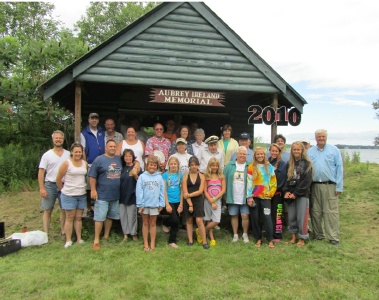
After World War II canoeing significantly changed in North America. People could
acquire canoes, including the new aluminum boats, and carry them on their cars. Membership
in canoe clubs declined. One by one Canoe club boat houses disappeared or became yacht
clubs. Canoeists camped at many locations, took long canoe trips and travelled to the
burgeoning number of canoe racing regattas throughout the county. National Championships
were established in addition to the old traditional Trophy Races at Sugar Island. All of this
led to a change in the population of Sugar Island. In light of the rapid expansion of activities,
Sugar Island became less important to the Board of Governors and Sugar Island was run by a
"Standing Committee" whose Chairman was appointed by the Commodore.
One of the major changes occurred at that time. About 1947-1948 there was great
consideration and argument about the building of cabins. Some wished to preserve the
natural beauty and camping aspect of the Island and some wished to establish a summer
resort. Finally, the cabin builders prevailed but the others got some regulations. All the
cabins were to be the same size and shape as designed by Commodore Thomas Zuk, an
architect, and to be located on certain selected sites on one end of the Island. One cabin was
built for the use of the Commodore and one cabin, built by Danny Zwart, for the use of the
sailors at New York Bay. The first cabins were built in 1952.
The cabin sites were to be applied for by members with consideration given to the
applicant’s contribution to the ACA, such as being an officer and active competitor or cruiser.
Thus began the era of Sugar Island for Sugar Islanders. This was a positive step in the
preservation of the Island and the continuation of ownership by the ACA.
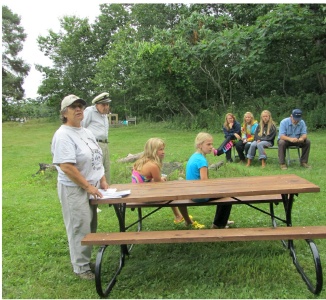 Other activities on the Island decreased and the major paddling regattas ceased in the
early 60's. Competition dwindled to the sailing, swimming and a small novelty regatta.
Other activities on the Island decreased and the major paddling regattas ceased in the
early 60's. Competition dwindled to the sailing, swimming and a small novelty regatta.
Commodore Bill Apfelbeck was the champion of Sugar Island and as Chairman of
the Board of Governors, made certain it was financed into the 1960's. When he left the
Board, Cabin residents like Henry Jahn took over the leadership.
Members of the ACA who lived in distant areas of the country or to whom the Island
meant very little always looked at Sugar as a source of money to run the ACA. Although
there is doubt as to whether the Island can really be sold, since the Provincial government
would like to add it to the Island Park system, the Islanders, allied with the Atlantic Division,
held a political stronghold in the ACA which outvoted any movements to sell, and elected
Commodores and other officials who were friendly to the Island. This was extremely
important to keeping the Island.
The next major change in the Island's political structure came in 1984 as the
constitution established Sugar Island as a separate identity governed by Board of Trustees,
elected by the congress for six year terms on a rotating basis. The first Trustees were Adolph
Springel, Larry Zuk, Chuck Tummonds, Don Jarrell, Dusty Rhodes and Brian Ireland.
Adolph was elected chairman and served diligently though 1999. He deserves much credit
for maintaining the physical and financial condition of the Island and continuing its
activities.
By the time this board was established the Sugar Island for Sugar Islanders period
was on the decline. A few old timers who had been active canoeists like Dusty Rhodes,
Adolph Springel, Joe Klecka and Chick Dermand were left, but most of the cabins had been
passed down to the second or third generation who were not avid racing or cruising
canoeists.
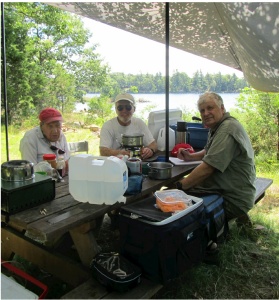 Through this period of the 70's, 80's and 90's, the primary canoeing activity at the
Encampments was sailing racing and much of the platform and all of the ground camping
was done by sailors. The fast growing group of IC sailors became the largest group of
competitors and they and their families began to participate in the governing of the Island
and running the activities of the Encampment.
Through this period of the 70's, 80's and 90's, the primary canoeing activity at the
Encampments was sailing racing and much of the platform and all of the ground camping
was done by sailors. The fast growing group of IC sailors became the largest group of
competitors and they and their families began to participate in the governing of the Island
and running the activities of the Encampment.
When Adolph discontinued his leadership, the work was assumed by non-cabin
owners and the younger users of the Island and the period of Sugar Island for Sugar Islanders
was over. Even cabins became available and were not eagerly grabbed up. The current Board
is Pearse O'Doherty, Robert Cassar, Scott Andrews, Kevin Dermond, Dick White, and Bob
Celifarco; and the chairman is Pearse O'Doherty. More effort is being made to attract other
ACA members to use the Island.
We all love Sugar as a place left largely as it was in 1903. From the Island we can see
drastic changes on the other islands and activities on the river, but here we can feel like
participants in an old sport that takes us away from civilization and back into the outdoors in
a relatively undisturbed environment.
Physically, the changes have occurred in the west end of the Island known as "Squaw
Camp". Starting in 1903, certain Canoe Clubs camped in locations picked by them and their
names became associated with places like New York Bay Buffalo Wallow, Rochester Bay
and Brooklyn Point. Single men had to camp on the East end of the Island on "Buck Point",
families camped in "Main Camp" and single ladies to the east in "Squaw Camp".
There was pride in the fact that the only wooden buildings on the Island were the
store and the ice house. There were platforms for a mess house and a cook house located at
the back of what is now the meadow behind Canoe Beach and were used until the mid 40's.
A little later a storage house was built to store the ACA tents and campers’ tents and
equipment over the winter. At headquarters there was a large tent and an officer’s tent in
addition to the three flag poles. One flag pole was replaced through a fund collected in honor
of Commodore Chuck Tummonds in 1986.
There was no well. We drank river water until the 80's. The first well was dug in the
70's. The new well was drilled in 1999.
The governors of the Island turned down many offers of electrical service by
companies that wanted to run wires over to the Island. In the 70's the generator was added to
provide electricity for evening activities, principally "Bingo".
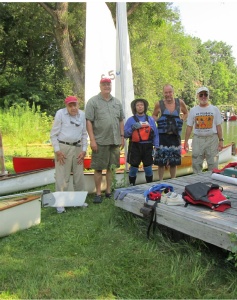 In 1972 the Ireland family donated the present building that replaced the officer’s
tent. Henry Callman left his estate to the ACA and $10,000 was set aside for a new
headquarters building at Sugar Island. Obviously, some of this money was spent on the HQ
pavilion dedicated in the late 70's.
In 1972 the Ireland family donated the present building that replaced the officer’s
tent. Henry Callman left his estate to the ACA and $10,000 was set aside for a new
headquarters building at Sugar Island. Obviously, some of this money was spent on the HQ
pavilion dedicated in the late 70's.
There was a large float alongside Headquarters Point in 1903 where the steamers
pulled in to load and unload. This was replaced by a large fixed wharf in the 20's which was
still there in the early 60's. The current wharf was donated by Bobby Jahn in 1984 in
Memory of his Father, Henry Jahn. Recently the old storehouse was replaced by a new
building.
From the beginning small docks, floats and inclines were built by individuals and are
still used. Inside the Islands, Salt and Pepper, large floats and wharfs have been built for
motor launches.
In the early days, transportation to the Island was furnished by the steamer "Yennek"
which brought the women and children and camp outfits over from Clayton while the men
sailed or paddled the canoes. That is the way I first came to the Island. In the thirties
transportation became less available and most people paddled or brought small motor boats,
like my dad and Lou Whitman had up to the 70's, when I paddled over from Chisamor's and
Lou took me back to sail my sailing canoe over and helped us leave towing the canoes.
In the 80's and 90's, the 1000 Island Motel provided a pontoon ferry which was a
great help but not so reliable. Now under new management as Mystie Isles Resort, the
pontoon boat provides good service in taking people to the Island, picking them up and
delivering ice and other items. Cellular phones make contact with the mainland so much
easier.
In the beginning Sugar Island was the center of the ACA. Starting just before and
immediately after World War II, the increased mobility of canoeists, the increase in
Divisional activity and the establishment of separate National Championships led to the
decline of interest by the AC A.
Financially, from the beginning it was difficult to get money for Sugar Island and the
National Encampment. Efforts to preserve the Island in the ACA were now left to the Island
users. Finally the Island was set up as a separate entity with its own Board of Trustees.
Now, as we finish the end of the first 100 years, the Island is used by cabin owners,
long term ACA participants, racing sailors and a few new cruisers and campers. In addition to
sailing races, the National Encampment provides a lively program for children, canoe and
kayak instruction, run by Chuck Southerland for a long time, swimming racing and evening
activities like the awards dinner and Bingo. The paddling racing, Novelty Regatta and
singing the old ACA songs around the campfire are but fond memories.
We owe a great debt of gratitude to all the people, too numerous to mention, who
gave of their money, time and talents over the past 100 years to leave us, in the ACA, this
beautiful place relatively undisturbed and nearly in the same state as it was in 1903.
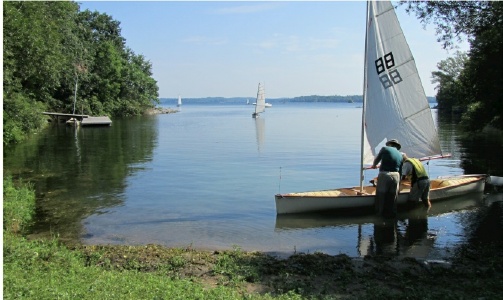
Return to table of contents
 The Search Committee consisted of Robert Wilkin and Charles E. Britton of
Gananoque and resulted in the purchase of the Island. The deed states that the lands
described as part and parcel of those lands set aside for the use of the Mississaguas of
Alnwick Indians were sold to Charles Edward Britton, Commodore of the American Canoe
association, and Robert Wilkin, Chairman of the Board of Governors of the ACA, for the
sum of $1000.00. The sale was officially recorded in Ottowa as July 18,1901. Island 47 was
purchased in 1919 and some small islands later.
The Search Committee consisted of Robert Wilkin and Charles E. Britton of
Gananoque and resulted in the purchase of the Island. The deed states that the lands
described as part and parcel of those lands set aside for the use of the Mississaguas of
Alnwick Indians were sold to Charles Edward Britton, Commodore of the American Canoe
association, and Robert Wilkin, Chairman of the Board of Governors of the ACA, for the
sum of $1000.00. The sale was officially recorded in Ottowa as July 18,1901. Island 47 was
purchased in 1919 and some small islands later.




